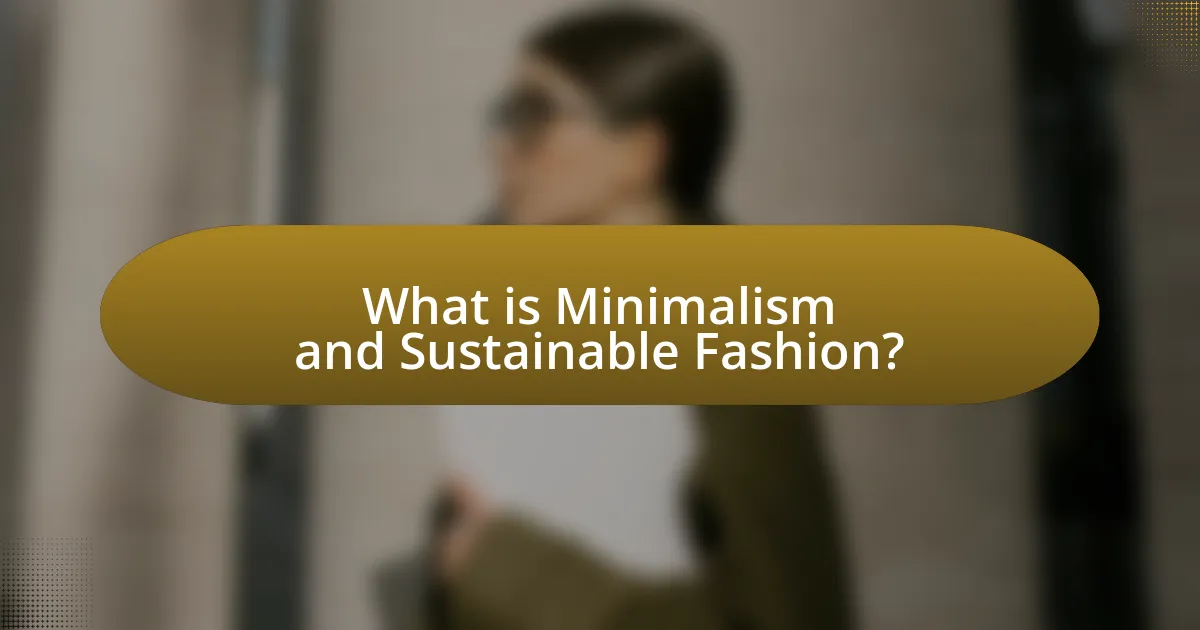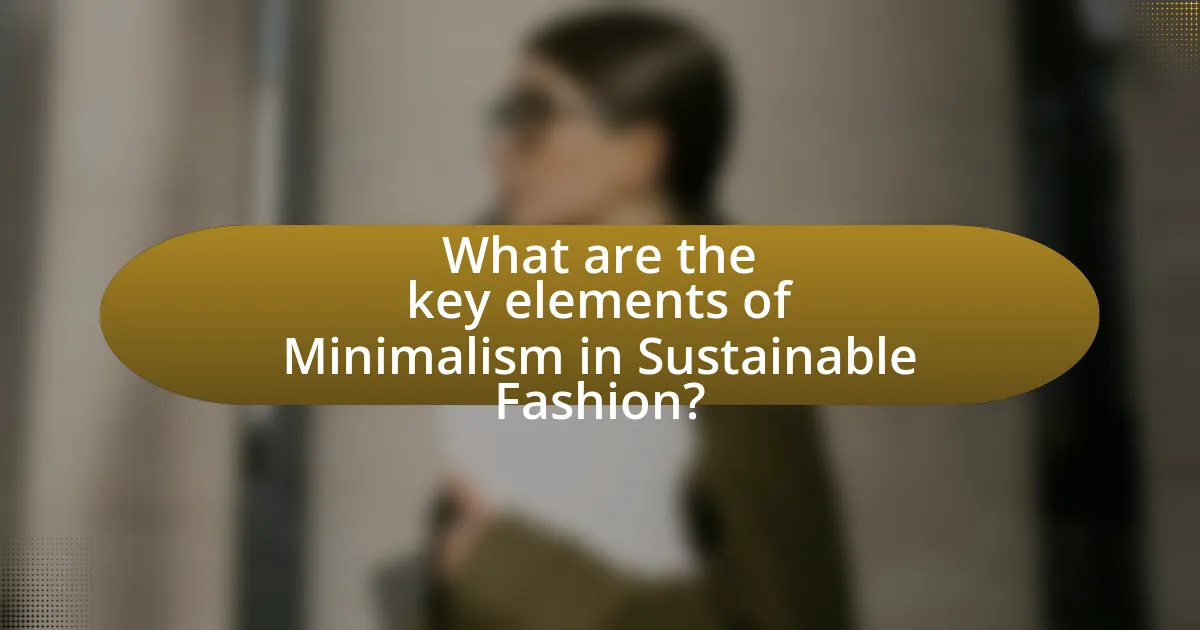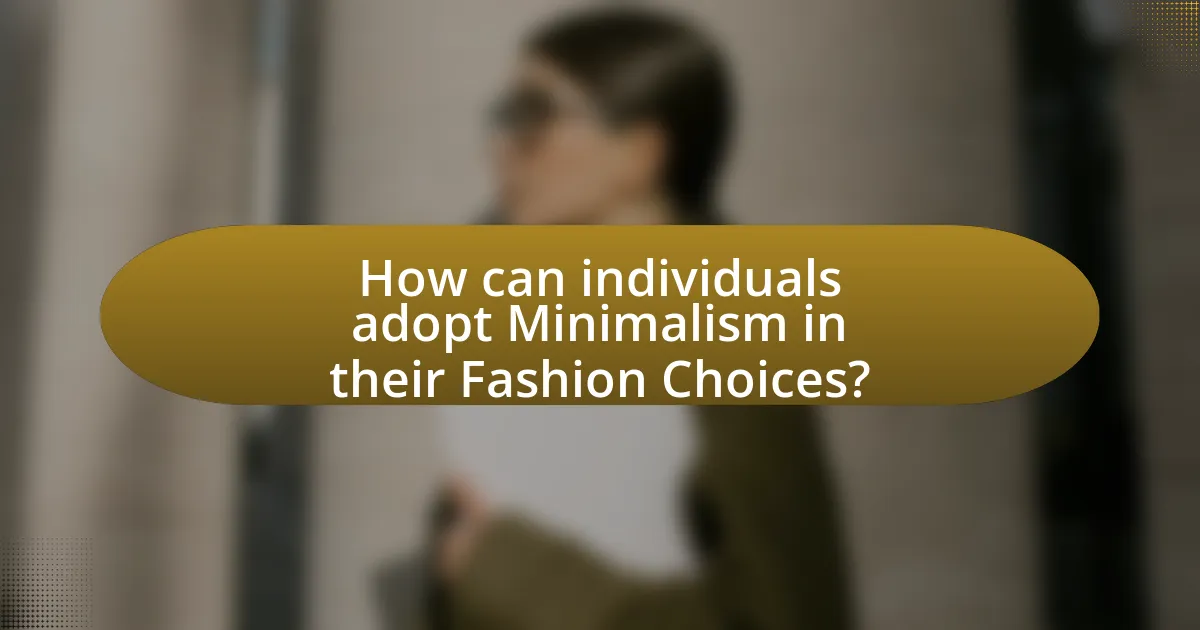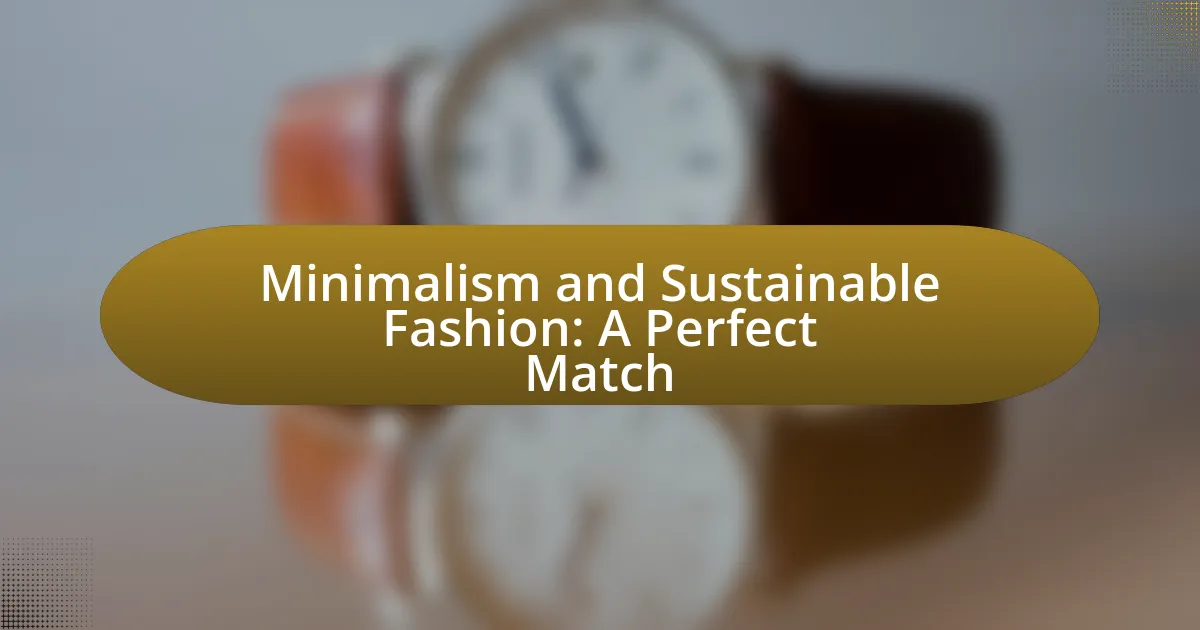Minimalism and sustainable fashion represent a lifestyle and design philosophy that prioritizes simplicity and ethical practices in clothing production. This article explores the intersection of these two concepts, highlighting how minimalism encourages reduced consumption and a focus on quality, which aligns with sustainable fashion’s goals of minimizing waste and environmental impact. Key principles of minimalism in fashion include simplicity, functionality, and timeless design, while sustainable fashion emphasizes ethical production and resource conservation. The article also discusses practical steps for adopting a minimalist wardrobe, the environmental benefits of this approach, and strategies for making mindful purchasing decisions, ultimately advocating for a more responsible and sustainable fashion culture.

What is Minimalism and Sustainable Fashion?
Minimalism is a lifestyle and design philosophy that emphasizes simplicity, focusing on the essential and eliminating the unnecessary. Sustainable fashion refers to clothing and accessories produced in environmentally friendly ways, prioritizing ethical practices, resource conservation, and reduced waste. Together, minimalism and sustainable fashion advocate for a conscious approach to consumption, encouraging individuals to invest in fewer, high-quality items that have a lower environmental impact, thus promoting a more sustainable and mindful way of living.
How do minimalism and sustainable fashion intersect?
Minimalism and sustainable fashion intersect through their shared emphasis on reducing consumption and prioritizing quality over quantity. Minimalism advocates for a simplified lifestyle that encourages individuals to own fewer, more meaningful items, which aligns with sustainable fashion’s goal of minimizing waste and environmental impact by promoting durable, ethically produced clothing. Research indicates that adopting a minimalist wardrobe can lead to a significant reduction in clothing purchases, thereby decreasing the overall demand for fast fashion, which is a major contributor to environmental degradation. This intersection fosters a conscious approach to fashion that values sustainability and intentionality in consumer choices.
What principles define minimalism in fashion?
Minimalism in fashion is defined by simplicity, functionality, and a focus on quality over quantity. This approach emphasizes a limited color palette, clean lines, and the use of versatile pieces that can be mixed and matched. The principle of sustainability is also integral, as minimalism encourages mindful consumption and the reduction of waste through fewer, well-made garments. Historical context shows that minimalist fashion gained prominence in the 1960s and 1970s, influenced by designers like Yves Saint Laurent and brands such as Jil Sander, who prioritized essential forms and understated elegance.
How does sustainable fashion contribute to minimalism?
Sustainable fashion contributes to minimalism by promoting the idea of quality over quantity, encouraging consumers to invest in fewer, high-quality garments that are ethically produced and environmentally friendly. This approach aligns with minimalism’s core principle of reducing excess and focusing on essential items, as sustainable fashion emphasizes timeless designs and durability, which leads to a more intentional wardrobe. Research indicates that the fast fashion industry is responsible for significant environmental degradation, with the production of clothing contributing to 10% of global carbon emissions; thus, choosing sustainable options helps minimize one’s ecological footprint while adhering to minimalist values.
Why is the combination of minimalism and sustainable fashion important?
The combination of minimalism and sustainable fashion is important because it promotes a reduction in consumption and waste while encouraging ethical production practices. Minimalism emphasizes owning fewer, high-quality items, which aligns with sustainable fashion’s goal of reducing the environmental impact of clothing production. According to a report by the Ellen MacArthur Foundation, the fashion industry is responsible for 10% of global carbon emissions, highlighting the need for more sustainable practices. By adopting minimalism, consumers can make more conscious choices, leading to a decrease in demand for fast fashion, which often relies on exploitative labor and environmentally harmful processes. This synergy fosters a more responsible approach to fashion that benefits both the planet and society.
What environmental benefits arise from adopting minimalism in fashion?
Adopting minimalism in fashion leads to significant environmental benefits, primarily by reducing waste and resource consumption. Minimalist fashion encourages consumers to buy fewer, higher-quality items, which decreases the frequency of purchases and the associated waste generated from fast fashion. According to a study by the Ellen MacArthur Foundation, the fashion industry is responsible for 92 million tons of waste annually, much of which comes from overproduction and discarded clothing. By embracing minimalism, individuals can contribute to lowering this waste, as they prioritize longevity and versatility in their wardrobe choices. Additionally, minimalism promotes sustainable practices, such as choosing eco-friendly materials and supporting ethical brands, further reducing the environmental impact of clothing production.
How does minimalism promote ethical consumerism?
Minimalism promotes ethical consumerism by encouraging individuals to prioritize quality over quantity in their purchases. This approach leads consumers to seek out sustainable and ethically produced goods, as minimalism emphasizes the importance of thoughtful consumption and reducing waste. Research indicates that minimalists are more likely to support brands that align with their values, such as those that practice fair labor and environmentally friendly production methods. For example, a study published in the Journal of Consumer Research found that consumers who adopt minimalist lifestyles tend to make more conscious purchasing decisions, favoring products that have a lower environmental impact and are produced under ethical conditions.

What are the key elements of Minimalism in Sustainable Fashion?
The key elements of Minimalism in Sustainable Fashion include simplicity, quality over quantity, and timeless design. Minimalism emphasizes a reduced aesthetic, focusing on fewer, well-made garments that are versatile and durable. This approach minimizes waste and encourages consumers to invest in high-quality pieces that last longer, thereby reducing the environmental impact associated with fast fashion. Research indicates that adopting a minimalist wardrobe can significantly decrease clothing consumption, which is a major contributor to textile waste and pollution.
How can consumers identify minimalist sustainable fashion brands?
Consumers can identify minimalist sustainable fashion brands by looking for specific characteristics such as a focus on timeless designs, high-quality materials, and transparent production practices. Minimalist brands often emphasize simplicity in their collections, avoiding excessive embellishments and promoting versatility in clothing. Additionally, these brands typically provide information about their sourcing, manufacturing processes, and environmental impact, which can be verified through certifications like Global Organic Textile Standard (GOTS) or Fair Trade. Research indicates that brands committed to sustainability often engage in ethical labor practices and use eco-friendly materials, making it easier for consumers to align their purchases with their values.
What characteristics should minimalist clothing possess?
Minimalist clothing should possess simplicity, functionality, and versatility. Simplicity is characterized by clean lines and a lack of excessive embellishments, allowing for a timeless aesthetic. Functionality ensures that each piece serves a practical purpose, often incorporating high-quality materials that enhance durability and comfort. Versatility allows garments to be easily mixed and matched, enabling multiple outfit combinations from a limited wardrobe. These characteristics align with the principles of sustainable fashion, as they promote longevity and reduce waste by encouraging consumers to invest in fewer, high-quality items rather than fast fashion alternatives.
How do minimalist brands ensure sustainability in their production processes?
Minimalist brands ensure sustainability in their production processes by prioritizing resource efficiency and ethical sourcing. These brands often utilize fewer materials and focus on high-quality, durable products that reduce waste over time. For instance, companies like Everlane and Reformation emphasize transparency in their supply chains, ensuring that materials are sourced responsibly and that labor practices are fair. Additionally, minimalist brands frequently adopt practices such as using organic or recycled materials, which significantly lower their environmental impact. Research indicates that sustainable fashion can reduce carbon emissions by up to 30% when brands implement eco-friendly production methods, reinforcing the effectiveness of minimalist approaches in promoting sustainability.
What role does quality play in minimalist sustainable fashion?
Quality is essential in minimalist sustainable fashion as it ensures longevity and reduces waste. High-quality materials and craftsmanship lead to durable garments that withstand the test of time, aligning with the principles of sustainability by minimizing the need for frequent replacements. For instance, a study by the Ellen MacArthur Foundation highlights that extending the life of clothing by just nine months can reduce carbon, water, and waste footprints by 20-30%. Thus, prioritizing quality in minimalist fashion not only supports sustainable practices but also promotes a more responsible consumption model.
Why is investing in quality garments beneficial for sustainability?
Investing in quality garments is beneficial for sustainability because it reduces waste and promotes longevity in clothing. High-quality garments are typically made from durable materials that withstand wear and tear, leading to a longer lifespan compared to fast fashion items. According to the Ellen MacArthur Foundation, extending the life of clothing by just nine months can reduce carbon, water, and waste footprints by 20-30%. This reduction in consumption and waste contributes significantly to a more sustainable fashion industry, as it minimizes the environmental impact associated with the production and disposal of low-quality garments.
How does quality impact the longevity of fashion items?
Quality significantly impacts the longevity of fashion items by determining their durability and resistance to wear and tear. High-quality materials and craftsmanship lead to garments that withstand frequent use and maintain their appearance over time. For instance, clothing made from natural fibers like wool or cotton typically lasts longer than those made from synthetic materials, as evidenced by studies showing that garments crafted with superior stitching and finishing techniques can last up to five times longer than lower-quality counterparts. This durability not only reduces the need for frequent replacements but also aligns with sustainable fashion principles by minimizing waste and resource consumption.

How can individuals adopt Minimalism in their Fashion Choices?
Individuals can adopt minimalism in their fashion choices by curating a capsule wardrobe that consists of versatile, high-quality pieces. This approach encourages the selection of a limited number of clothing items that can be mixed and matched, reducing clutter and promoting intentional purchasing. Research indicates that a capsule wardrobe can lead to a more sustainable lifestyle, as it minimizes waste and encourages mindful consumption. For instance, a study published in the Journal of Cleaner Production highlights that reducing clothing purchases can significantly decrease environmental impact, supporting the idea that minimalism aligns with sustainable fashion practices.
What practical steps can one take to embrace minimalism in their wardrobe?
To embrace minimalism in one’s wardrobe, start by decluttering and removing items that are rarely worn or no longer serve a purpose. This can be achieved by evaluating each piece of clothing based on its utility and emotional value, leading to a more streamlined collection. Research indicates that a minimalist wardrobe can reduce decision fatigue and enhance personal style, as seen in studies showing that individuals with fewer clothing options often report higher satisfaction with their outfits. Next, focus on quality over quantity by investing in versatile, durable pieces that can be mixed and matched, which supports sustainable fashion practices. Additionally, consider adopting a one-in-one-out rule to maintain a balanced wardrobe, ensuring that new purchases do not lead to excess.
How can decluttering contribute to a minimalist wardrobe?
Decluttering significantly contributes to a minimalist wardrobe by reducing the number of clothing items to only those that are essential and truly valued. This process allows individuals to identify and keep only versatile pieces that align with their personal style and lifestyle needs, thereby promoting a more intentional approach to fashion. Research indicates that a minimalist wardrobe can lead to improved decision-making and reduced stress related to outfit choices, as fewer items simplify daily routines. Additionally, studies show that maintaining a minimalist wardrobe can enhance sustainability by encouraging the purchase of higher-quality, longer-lasting garments, ultimately reducing waste in the fashion industry.
What strategies can help in making mindful purchasing decisions?
To make mindful purchasing decisions, individuals should adopt strategies such as creating a budget, prioritizing needs over wants, and researching products before buying. Establishing a budget helps limit unnecessary spending, while focusing on needs ensures that purchases align with personal values and sustainability goals. Researching products, including their environmental impact and ethical production practices, allows consumers to make informed choices that support sustainable fashion. According to a study by the Journal of Consumer Research, informed consumers are more likely to engage in sustainable purchasing behaviors, reinforcing the importance of these strategies.
What are the challenges of integrating minimalism with sustainable fashion?
Integrating minimalism with sustainable fashion presents challenges such as consumer perception, production practices, and market demand. Consumers often associate minimalism with a lack of variety, which can conflict with the diverse offerings typically expected in sustainable fashion. Additionally, sustainable fashion relies on ethical production methods that may not align with the streamlined, cost-effective processes favored in minimalism. For instance, sustainable materials can be more expensive and less readily available, complicating the minimalist approach of owning fewer, high-quality items. Furthermore, the market demand for fast fashion contradicts the minimalist ethos of intentional consumption, making it difficult for brands to balance these two philosophies effectively.
How can consumers overcome the temptation of fast fashion?
Consumers can overcome the temptation of fast fashion by adopting a minimalist mindset that prioritizes quality over quantity. This approach encourages individuals to focus on purchasing fewer, high-quality items that are versatile and durable, rather than succumbing to the allure of cheap, trendy clothing that quickly goes out of style. Research indicates that the average consumer buys 60% more clothing than in 2000 but keeps each item for half as long, highlighting the need for a shift towards sustainable purchasing habits. By embracing minimalism, consumers can reduce their environmental impact and make more thoughtful choices, ultimately leading to a more sustainable wardrobe.
What misconceptions exist about minimalism and sustainable fashion?
Misconceptions about minimalism and sustainable fashion include the belief that minimalism is solely about owning fewer items, which overlooks its emphasis on quality and intentionality in consumption. Additionally, some think sustainable fashion is only about eco-friendly materials, ignoring the importance of ethical labor practices and the overall lifecycle of garments. Research by the Ellen MacArthur Foundation highlights that sustainable fashion encompasses reducing waste and promoting circularity, which is often misunderstood as merely reducing the number of clothes owned.
What are some best practices for maintaining a minimalist sustainable wardrobe?
To maintain a minimalist sustainable wardrobe, prioritize quality over quantity by selecting versatile, durable pieces that can be mixed and matched. This approach reduces the need for excessive clothing and minimizes waste. Additionally, practice mindful shopping by assessing your needs and avoiding impulse purchases, which aligns with sustainable fashion principles. Regularly declutter your wardrobe to remove items that no longer serve you, ensuring that only essential and loved pieces remain. According to a study by the Ellen MacArthur Foundation, extending the life of clothing by just nine months can reduce carbon, water, and waste footprints by 20-30%.
How can regular wardrobe audits enhance sustainability?
Regular wardrobe audits enhance sustainability by promoting mindful consumption and reducing waste. By evaluating clothing items, individuals can identify pieces that are rarely worn, leading to informed decisions about donating, recycling, or repurposing garments. This practice not only minimizes landfill contributions but also encourages a shift towards quality over quantity, fostering a more sustainable fashion culture. Studies indicate that the average person wears only 20% of their wardrobe regularly, highlighting the potential for significant waste reduction through audits.
What tips can help in creating versatile outfits with minimal pieces?
To create versatile outfits with minimal pieces, focus on selecting a capsule wardrobe that includes neutral colors, timeless styles, and interchangeable items. Neutral colors such as black, white, gray, and beige allow for easy mixing and matching, while timeless styles like tailored blazers and classic jeans ensure longevity in fashion. Interchangeable items, such as a versatile dress that can be styled for both casual and formal occasions, enhance outfit adaptability. Research indicates that a well-curated capsule wardrobe can reduce decision fatigue and promote sustainable fashion choices by minimizing consumption and waste.

Leave a Reply